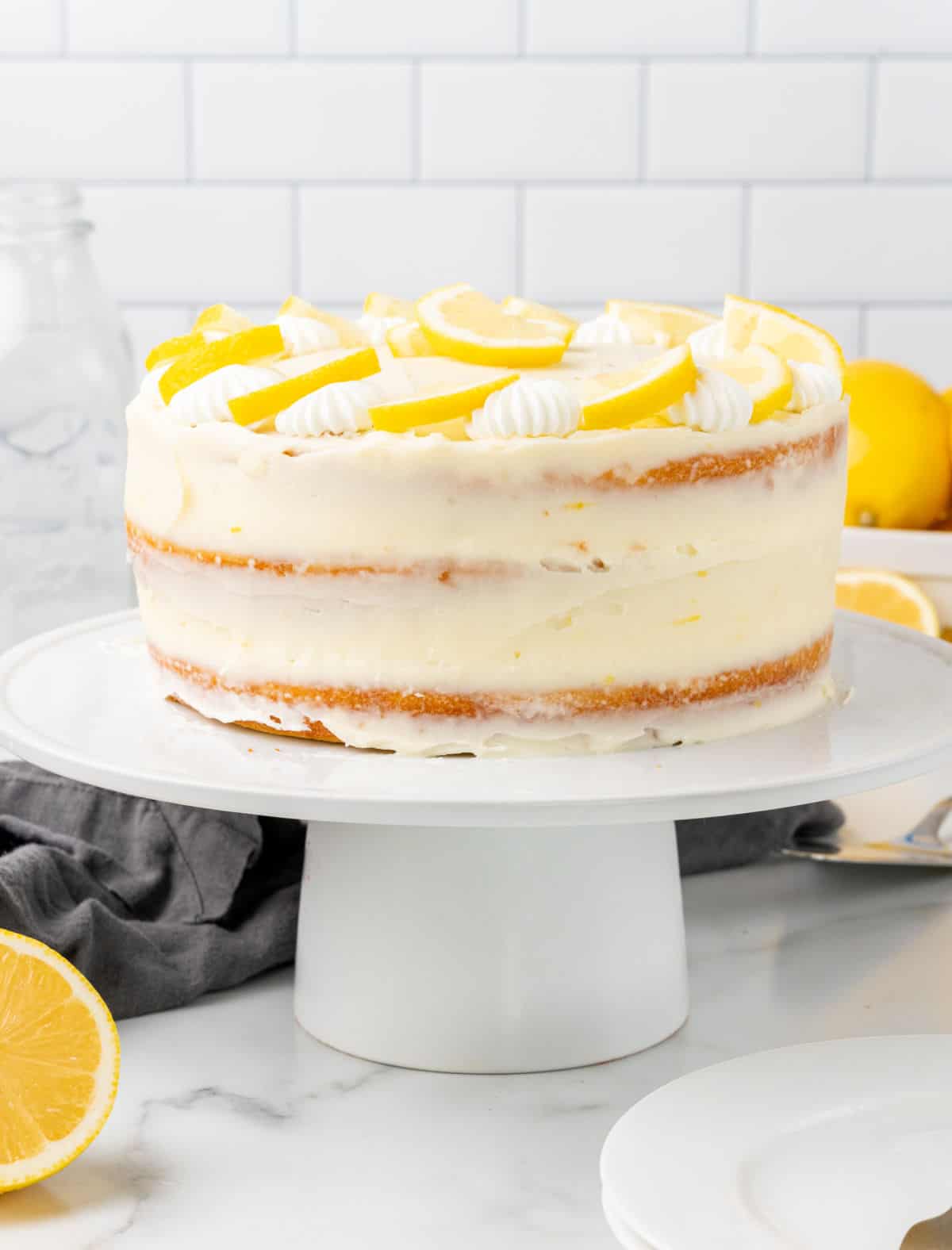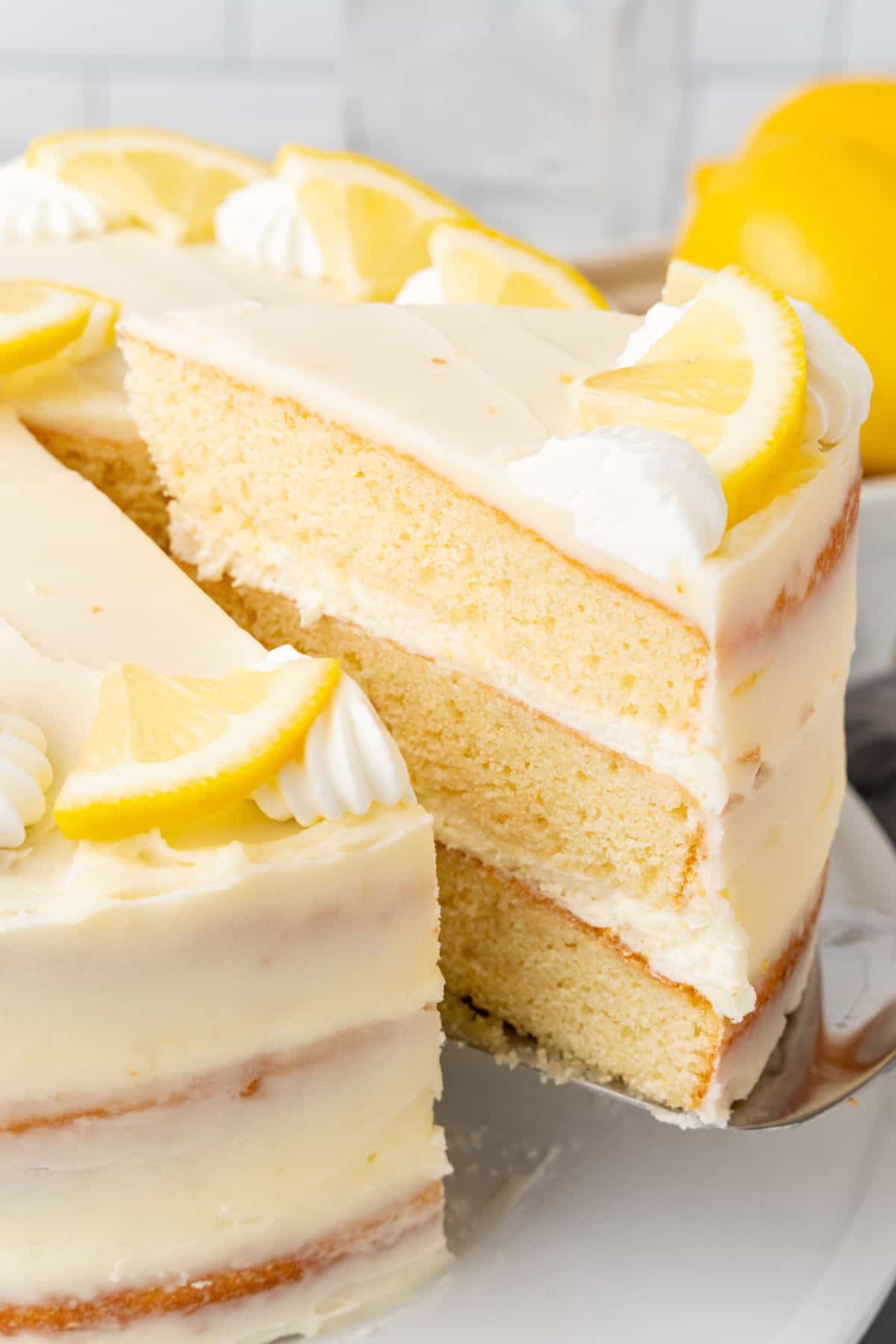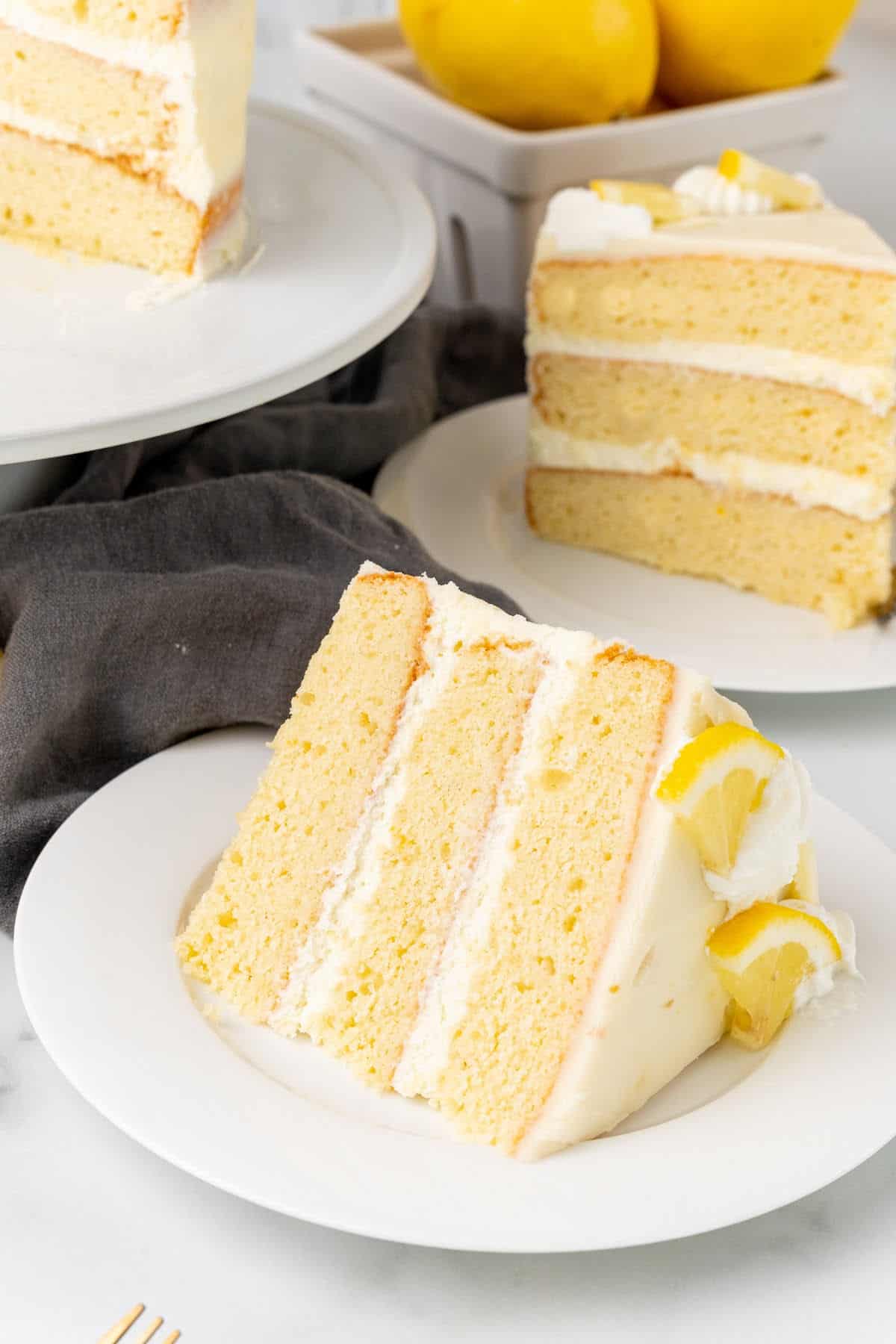A beautiful and different lemon layer cake, more similar to a pound cake in texture than a sponge cake, filled with fluffy whipped cream and frosted with a lemony cream cheese frosting. It's sweet, easy to make, with simple flavors, and perfect for small gatherings, birthdays, a baby shower, Mother's Day, or a Spring celebration brunch.

I used to make this recipe as a loaf cake with a simple glaze. It was wonderful and perfect for an afternoon cup of tea. And it is still a great idea.
But times changed and I eventually posted my favorite Lemon Sour Cream Pound Cake.
So I decided to try it as a layer cake, double down on the cream factor and use a fluffy, sweet whipped cream as filling and our beloved lemon cream cheese frosting that holds better when the cake is cut.
A beautiful Spring cake with simple flavors and light colors.

Ingredient list
- Lemon:
- All-purpose or cake flour.
- Baking powder: is used as leavener to help the scones rise, so make sure it isn't expired.
- White granulated sugar.
- Salt: I like using kosher salt when baking. But regular table salt works just fine.
- Eggs: fresh, large.
- Milk: I always use whole milk because of its richness, but reduced-fat milk also works.
- Vanilla: I use pure vanilla extract or pure vanilla paste when available, but a good vanilla essence (artificially flavored) also works and is infinitely cheaper.
- Cream cheese: the regular type, full-fat cream cheese is needed for consistency and creaminess. I always use Philadelphia original cream cheese, but other premium brands work fine.
- Powdered sugar: also called confectioners or icing sugar, you can easily buy it online. Domino powdered sugar is a very popular one.
- Unsalted butter.
- Cream: heavy, heavy whipping, or whipping cream.

How to make the lemon cake
This is a butter cake heavily flavored with lemon zest and lemon juice.
Mixing equipment: use an electric mixer or stand mixer (with the paddle attachment) to make beating easier, especially during the creaming step. Aerating the ingredients is essential to achieve fluffy and not heavy cake layers.

Use 3 round cake pans for faster and more even baking. You can make a four-layer cake if you use two pans due to oven space.

The baked cake will be light in color but golden around the edges and bottom. They should be completely cold before filling and frosting them.
The cream filling
I decided to keep it simple and use whipped cream, lightly sweetened, with a few tablespoons of cream cheese to give it more structure.
This is a trick I read in one of Nancy Silverton's books decades ago and always use it.

The whipped cream filling should be beaten to stiff peaks so it doesn't drip down the sides. To avoid the chance of curdling it, you can use a whisk at the end as it's harder to overwhip it by hand.

Invert cakes so the surface is smoother, making it easier to spread the creamy filling.
The frosting
I'm a big fan of cream cheese frosting. Huge.
So I decided to use a lemon-flavored one, similar to the top layer of the Coconut Lemon Sheet Cake. Easy, fast, and delicious.

The traditional cream cheese frosting is enhanced with lemon zest for an extra dose of citrus.

Frost the top of the cake and sides. We add a not-so-thick layer, but you can completely cover the sides of the cake and not let the layers show as we do.
Number of cake layers
The number of tiers is dictated by how much oven space you have and how many pans fit at the same time.
- Three layers: this is a nice amount of layers, and I recommend two sizes: 7-inch pans for a smaller cake like the images in this post, but with thicker layers, or 8-inch pans for a thinner layered cake. Always use a springform pan that makes removing the cake easier.
- Two layers: this is another alternative, and I recommend 8-inch pans for a thicker layered cake and a 9-inch cake pan for a larger cake.
- Four layers: if you bake the lemon cake batter in 2 pans due to oven space, you can cut each in half and make a 4-tier cake with three layers of cream filling.
Both are made with the same amount of batter; for me, it comes down to the type of event where I'm serving it.
Taller cakes are more of a showstopper, especially if you decorate them with flowers, for example. In comparison, two-layer cakes are easier to transport, cut, and handle for an intimate birthday.
Either way, the cake will be just as delicious.

How to get more lemon flavor
- Fresh lemons: we use lemon zest and fresh lemon juice in the cake batter and frosting. It's the most natural way to flavor a lemon cake.
- Lemon sugar: you can work the lemon zest into the sugar at the beginning, before creaming it with the butter. The peel will release some of its natural oils and impregnate the sugar. This adds an extra punch of flavor.
- Lemon extract or emulsion: using it can quickly and easily enhance the lemon flavor. I use pure ones like Nielsen Massey pure lemon extract or Mc Cormick culinary pure lemon extract. There are artificially flavored ones that you can use if you know are good, like Frontier lemon flavor.
- Paste and emulsion: these are thicker than extracts and concentrate a lot of flavor. I love and regularly use vanilla paste but have never tried a citrus alternative. But I heard good things from both Nielsen Massey Pure lemon paste and LorAnn lemon emulsion.
Kitchen notes
- Organization: read the recipe first and ensure you have ingredients at the correct temperature, equipment, and enough workspace. This will make the process so much easier.
- Baking time: keep in mind that all ovens and pans are different, even if they look similar. The baking time in my recipes is as accurate as it can be, but it might take you more or less time. You can use a thermometer(like the OXO oven thermometer) to check that your oven is at the right temperature. I recommend you keep track of how your oven works and what tiny details you might need to adjust.
- Layers: don't overbake them! When they're springy to the touch or a cake tester comes out clean, take them out of the oven. This recipe is more like a pound cake in texture, so overbaking is never a good idea. That's why I don't recommend refrigerating them for several days so they don't dry out. I like to use them the next day I bake them.
- Make ahead: the layers and filling can be made ahead. Keep the former well wrapped in plastic until ready to use, refrigerated for no more than 2 days, or frozen for a few weeks. The cream cheese filling lasts for a few weeks in the refrigerator in an airtight container.

We love lemon cream cheese frosting. You can find the recipe in the post for Coconut Lemon Sheet Cake.
Because you didn't have the butter and the cream cheese at room temperature. It's a necessary step to let them soften so that they integrate well when you mix them. They should be completely smooth before you add the powdered sugar.
It lasts 2 or 3 days in the refrigerator, well stored. You should always cover it or store it in an airtight container. But keep in mind that it will be different in appearance, with more air and the appearance of a 'bubbly' texture sometimes.
No, they're different. Heavy cream has a higher fat content and, ironically, will whip better and hold the shape longer than whipping cream. There's a 'heavy whipping cream' which might be the best, though it's very similar to heavy cream.

Related recipes you might like:
Before you go
If you made this recipe and loved it, you can comment below and leave a five-star ⭐️ review. Also, if you had issues, let me know so we can troubleshoot together.
You can also subscribe to our FREE email series 'Baking the Best' and our regular newsletter. Or follow and save my recipes on Pinterest.

Lemon Cream Cake
Ingredients
For the cake:
- 2 ¾ cups all-purpose or cake flour
- 1 teaspoon baking powder
- ¼ teaspoon salt
- 1 cup unsalted butter, at room temperature
- 2 cups white sugar
- 1 tablespoon lemon zest, about 1 lemon
- 4 eggs, at room temperature
- ¾ cup milk, at room temperature
- ¼ cup fresh lemon juice
- ½ teaspoon vanilla extract
For the filling:
- 2 cups whipping, heavy whipping, or heavy cream, cold
- 4 tablespoons cream cheese or mascarpone, cold
- 5 tablespoons powdered sugar
For the frosting:
- ½ cup cream cheese, at room temperature
- 3 tablespoons unsalted butter, at room temperature
- 1 ½ to 2 cups powdered sugar, you might need more to make it thick enough
- 1 teaspoon lemon zest
Instructions
For the cake:
- Preheat the oven to 350ºF (180ºC).
- Butter or spray three 8-inch cake pans with removable bottoms (or 2 if making 9-inch layers). Line the bottom with a round piece of parchment paper if you want. Or dust the whole pan with flour, shaking off excess.
- In a large bowl, beat butter at medium speed while gradually adding sugar until creamy, 2-3 minutes.
- Add zest and eggs, one at a time, beating well each time to combine.
- Sift the dry ingredients: flour, baking powder, and salt (I do it directly over the butter mix, but you can sift them in a separate bowl) and add it in 3 parts to the butter mixture, alternating with the milk, lemon juice, and vanilla in 2 parts. This means you'll start and end with the flour.
- Mix well at low speed, but don’t overbeat at this point of the cake will be tough.
- Pour mixture into prepared pans, and bake for 25-30 minutes or until a cake tester or toothpick comes out clean.
- Let cool for 20 minutes on a wire rack and carefully unmold.
- Peel the paper (if using) and let it cool completely before frosting. It is best to wrap and refrigerate it for 1 day before frosting.
For the filling:
- Beat cold cream with cream cheese and sugar until medium-firm peaks form.
- Finish with a hand whisk until you have a firm consistency. I always recommend this to avoid overbeating, which may curdle the cream. By hand, it's easier to control the beating.
For the frosting:
- Beat cream cheese with butter until smooth and creamy.
- Add sugar until you have a thick consistency.
- Add lemon zest and mix well.
- Adjust powdered sugar if you want a thicker frosting.
- Keep covered and refrigerated.
To assemble:
- Invert the cooled cake layers so the bottom becomes the top. The surface is smoother; that's why we do this.
- Place the first cake layer on a cake plate and fill it with whipped cream filling, dividing it evenly depending on how many tiers the cake will have.
- Smooth with a spatula leaving about half an inch around the edges without filling.
- Place the second cake layer on top and gently press. The filling will expand, sealing the edges.
- Repeat with the rest of the whipped cream and the last cake layer.
- Frost with the lemon cream cheese frosting, on both the top and sides. You can make a semi-naked cake so parts of the layers show. Or you can cover them with a thick layer of frosting, covering the outside of the cake completely.
- Decorate with lemon rind, slices, piped whipping cream, frosting, or edible flowers.






Renda says
Can this cake be made in a bundt cake pan.?
Paula Montenegro says
Hi Renda! I’ve made it in loaf pans, so it should work as a Bundt cake. The baking time will be substantially more than layers.
Renda says
Thank you for your reply, i will give it a try in a bundt pan.
Earl C Williams says
Love it.
And may I say I love your easy going, open and honest dialogue when talking to us. You are very personable. I wish you still had your shoppe and all of us fans could come in everyday and listen to you and eat your desserts. That would be something close to heaven.
Paula Montenegro says
Thanks Earl for your kind words! Sharing food is always the best plan.
David says
Paula,
I am so glad to be getting your posts again! I have missed you! For this cake, I like the idea of using it for. a trifle!
Paula Montenegro says
Yes David, I have missed you too, such a long time! But I'm back with a plan, haha. It is a super cake for a trifle!
The Ninja Baker says
Gracias Paula for the great tips! Your lemon cake does sound amazing and with a limoncello glaze? Yes., please!!!
Paula Montenegro says
Thanks Kim!